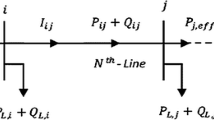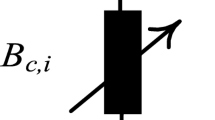Abstract
In a typical power system network, transmission losses are considered as one of the important parameters for economic operation. To concern this problem, researchers have proposed many techniques to minimize the transmission losses based on the cost benefit analysis which is associated with the optimal placement of the reactive power sources. In the present work, a novel technique, namely oppositional crow search algorithm (CSA), is proposed for Var planning by utilizing the fuzzy logic technique to determine capacitor placement positions. In this approach, fuzzy membership value is calculated based on the loss sensitivity factor of each bus of the test networks. Then, shunt capacitors placement positions are assigned to buses having the higher membership values. Once the capacitor placement positions are evaluated, the CSA and oppositional CSA are executed to obtain the optimal setting of transformer tap positions, reactive power generation of the generators, and magnitude of shunt capacitors placed at the weak nodes. The proposed method is performed on standard IEEE 30 and IEEE 57 bus networks, and the obtained results are compared with several other established methods for Var planning. From the obtained results, it is found that the proposed method shows better performance when compared to other techniques suggested in the literature in terms of reduced active power loss and system operating cost.

















Similar content being viewed by others
Availability of data and material
All data generated or analyzed during this study are included in this published article.
References
Abdul-Rahman, K. H., & Shahidehpour, S. M. (1993). A fuzzy-based optimal reactive power control. IEEE Transactions on Power Systems, 8(2), 662–670.
Abou El Ela, A. A., Abido, M. A., & Spea, S. R. (2011). Differential evolution algorithm for optimal reactive power dispatch. Electric Power Systems Research, 81(2), 458–464.
Askarzadeh, A. (2016). A novel metaheuristic method for solving constrained engineering optimization problems: Crow search algorithm. Computers & Structures, 169, 1–12.
Babu, R., Raj, S., Dey, B., & Bhattacharyya, B. (2021). Optimal reactive power planning using oppositional grey wolf optimization by considering bus vulnerability analysis. Energy Conversion and Economics. https://doi.org/10.1049/enc2.12048
Badi, M., Mahapatra, S., & Raj, S. (2021). Hybrid BOA-GWO-PSO algorithm for mitigation of congestion by optimal reactive power management. Optimal Control Applications and Methods. https://doi.org/10.1002/oca.2824
Bhattacharyya, B., & Babu, R. (2016). Teaching learning based optimization algorithm for reactive power planning. International Journal of Electrical Power & Energy Systems, 81, 248–253.
Bhattacharyya, B., & Goswami, S. K. (2007). Reactive power optimization through evolutionary techniques: A comparative study of the GA, DE and PSO algorithms. Intelligent Automation & Soft Computing, 13(4), 453–461.
Bhattacharyya, B., Goswami, S. K., & Bansal, R. C. (2009). Loss sensitivity approach in evolutionary algorithms for reactive power planning. Electric Power Components and Systems, 37(3), 287–299.
Bhattacharyya, B., & Karmakar, N. (2019). Optimal reactive power management problem: A solution using evolutionary algorithms. IETE Technical Review, 37, 1–9.
Bhattacharyya, B., & Karmakar, N. (2020). A planning strategy for reactive power in power transmission network using soft computing techniques. International Journal of Power and Energy Systems, 40(3), 141–148.
Bhattacharyya, B., & Raj, S. (2016). PSO based bio inspired algorithms for reactive power planning. International Journal of Electrical Power & Energy Systems, 74, 396–402.
Bhattacharyya, B., Rani, S., Vais, I. R., & Bharti, P. I. (2016). GA based optimal planning of VAR sources using Fast Voltage Stability Index method. Archives of Electrical Engineering, 65(4), 789–802.
Bie, Z. H., Song, Y. H., Wang, X. F., Taylor, G. A., & Irving, M. R. (2006). Integration of algorithmic and heuristic techniques for transition-optimised voltage and reactive power control. IEE Proceedings-Generation, Transmission and Distribution, 153(2), 205–210.
Chattopadhyay, D., & Chakrabarti, B. B. (2002). RPP incorporating voltage stability. International Journal of Electrical Power & Energy Systems, 24(3), 185–200.
Chen, Y.-L. (1996). Weak bus oriented RPP for system security. IEE Proceedings-Generation, Transmission and Distribution, 143(6), 541–545.
Chiang, H.-D., Wang, J.-C., Cockings, O., & Shin, H.-D. (1990a). Optimal capacitor placements in distribution systems. I. A new formulation and the overall problem. IEEE Transactions on Power Delivery, 5(2), 634–642.
Chiang, H.-D., Wang, J.-C., Cockings, O., & Shin, H.-D. (1990b). Optimal capacitor placements in distribution systems. II. Solution algorithms and numerical results. IEEE Transactions on Power Delivery, 5(2), 643–649.
Dai, C., Chen, W., Zhu, Y., & Zhang, X. (2009). Seeker optimization algorithm for optimal reactive power dispatch. IEEE Transactions on Power Systems, 24(3), 1218–1231.
Duman, S., Sonmez, Y., Güvenç, U., & Yörükeren, N. (2012). Optimal reactive power dispatch using a gravitational search algorithm. IET Generation, Transmission & Distribution, 6(6), 563–576.
Ettappan, M., Vimala, V., Ramesh, S., & Kesavan, V. T. (2020). Optimal reactive power dispatch for real power loss minimization and voltage stability enhancement using artificial bee colony algorithm. Microprocessors and Microsystems, 76, 103085.
Ganguly, S., Shiva, C. K., & Mukherjee, V. (2018). Frequency stabilization of isolated and grid connected hybrid power system models. Journal of Energy Storage, 19, 145–159.
Gao, B., Morison, G. K., & Kundur, P. (1992). Voltage stability evaluation using modal analysis. IEEE Transactions on Power Systems, 7(4), 1529–1542.
Ghose, T., Goswami, S. K., & Basu, S. K. (1999). Solving capacitor placement problems in distribution systems using genetic algorithms. Electric Machines & Power Systems, 27(4), 429–441.
Gomes, P. V., & Saraiva, J. T. (2020). A two-stage strategy for security-constrained AC dynamic transmission expansion planning. Electric Power Systems Research, 180, 106167.
Gudadappanavar, S. S., & Mahapatra, S. (2021). Metaheuristic nature-based algorithm for optimal reactive power planning. International Journal of System Assurance Engineering and Management. https://doi.org/10.1007/s13198-021-01489-x
Jabr, R. A. (2011). Optimization of reactive power expansion planning. Electric Power Components and Systems, 39(12), 1285–1301.
Jeyadevi, S., Baskar, S., & Iruthayarajan, M. W. (2011). RPP with voltage stability enhancement using covariance matrix adapted evolution strategy. European Transactions on Electrical Power, 21(3), 1343–1360.
Karmakar, N., & Bhattacharyya, B. (2018). A memory based meta-heuristic optimizer for optimal VAr management in power transmission system. In 2018 5th IEEE Uttar Pradesh section international conference on electrical, electronics and computer engineering (UPCON) (pp. 1–5). IEEE.
Lai, L. L., & Ma, J. T. (1997). Application of evolutionary programming to reactive power planning-comparison with nonlinear programming approach. IEEE Transactions on Power Systems, 12(1), 198–206.
Lee, K. Y., Member, S., & Yang, F. F. (1998). Optimal RPP using evolutionary algorithms: A comparative study for evolutionary programming, evolutionary strategy, genetic algorithm, and linear programming. IEEE Transactions on Power Systems, 13(1), 101–108.
Lin, S.-S., & Horng, S.-C. (2012). Iterative simulation optimization approach for optimal volt-ampere reactive sources planning. International Journal of Electrical Power & Energy Systems, 43(1), 984–991.
Mahapatra, S., Badi, M., & Raj, S. (2019). Implementation of PSO, it’s variants and Hybrid GWO-PSO for improving reactive power planning. In 2019 global conference for advancement in technology (GCAT) (pp. 1–6). IEEE.
Mahapatra, S., Dey, B., & Raj, S. (2021). A novel ameliorated Harris hawk optimizer for solving complex engineering optimization problems. International Journal of Intelligent Systems, 36(12), 7641–7681.
Mahdad, B. (2019). Optimal reconfiguration and reactive power planning based fractal search algorithm: A case study of the Algerian distribution electrical system. Engineering Science and Technology, an International Journal, 22(1), 78–101.
Mantovani, J. R. S., & Garcia, A. V. (1996). A heuristic method for reactive power planning. IEEE Transactions on Power Systems, 11(1), 68–74.
Miu, K. N., Chiang, H. D., & Darling, G. (1997). Capacitor placement, replacement and control in large-scale distribution systems by a GA-based two-stage algorithm. IEEE Transactions on Power Systems, 12(3), 1160–1166.
Nandi, M., Shiva, C. K., & Mukherjee, V. (2017). TCSC based automatic generation control of deregulated power system using quasi-oppositional harmony search algorithm. Engineering Science and Technology, an International Journal, 20(4), 1380–1395.
Outlook, A. E. (2010). Energy information administration. Department of Energy, 92010(9), 1–15.
Parida, S. K., Singh, S. N., & Srivastava, S. C. (2008). A hybrid approach toward security-constrained RPP in electricity markets. Electric Power Components and Systems, 36(6), 649–663.
Raj, S., & Bhattacharyya, B. (2016). Weak bus-oriented optimal Var planning based on grey wolf optimization. In 2016 national power systems conference (NPSC) (pp. 1–5). IEEE.
Raj, S., & Bhattacharyya, B. (2018). Reactive power planning by opposition-based grey wolf optimization method. International Transactions on Electrical Energy Systems, 28(6), 2551.
Raj, S., Mahapatra, S., Shiva, C. K., & Bhattacharyya, B. (2021). Implementation and optimal sizing of TCSC for the solution of reactive power planning problem using quasi-oppositional Salp swarm algorithm. International Journal of Energy Optimization and Engineering (IJEOE), 10(2), 74–103.
Samala, R. K., & Kotapuri, M. R. (2020). Optimal allocation of distributed generations using hybrid technique with fuzzy logic controller radial distribution system. SN Applied Sciences, 2(2), 1–14.
Shaw, B., Mukherjee, V., & Ghoshal, S. P. (2014). Solution of reactive power dispatch of power systems by an opposition-based gravitational search algorithm. International Journal of Electrical Power & Energy Systems, 55, 29–40.
Shekarappa, G. S., Mahapatra, S., & Raj, S. (2021a). Voltage constrained reactive power planning problem for reactive loading variation using hybrid Harris hawk particle swarm optimizer. Electric Power Components and Systems, 9(4–5), 421–435.
Shekarappa, G. S., Mahapatra, S., & Raj, S. (2021b). Voltage constrained reactive power planning by ameliorated HHO technique. In O. H. Gupta & V. K. Sood (Eds.), Recent advances in power systems (pp. 435–443). Springer.
Subbaraj, P., & Rajnarayanan, P. N. (2010). Hybrid particle swarm optimization based optimal reactive power dispatch. International Journal of Computer Applications, 1(5), 65–70.
Tizhoosh, H. R. (2005). Opposition-based learning: A new scheme for machine intelligence. In International conference on computational intelligence for modelling, control and automation and international conference on intelligent agents, web technologies and internet commerce (CIMCA-IAWTIC'06) (vol. 1, pp. 695–701). IEEE.
Viswanadha Raju, G. K., & Bijwe, P. R. (2008). Reactive power/voltage control in distribution systems under uncertain environment. IET Generation, Transmission & Distribution, 2(5), 752–763.
Yang, N., Yu, C. W., Wen, F., & Chung, C. Y. (2007). An investigation of RPP based on chance constrained programming. International Journal of Electrical Power & Energy Systems, 29(9), 650–656.
Zhang, H., Cheng, H., Liu, L., Zhang, S., Zhou, Q., & Jiang, L. (2019). Coordination of generation, transmission and reactive power sources expansion planning with high penetration of wind power. International Journal of Electrical Power & Energy Systems, 108, 191–203.
Zhu, J., Cheung, K., Hwang, D., & Sadjadpour, A. (2010). Operation strategy for improving voltage profile and reducing system loss. IEEE Transactions on Power Delivery, 25(1), 390–397.
Zhu, J. Z., & Xiong, X. F. (2003). Optimal reactive power control using modified interior point method. Electric Power Systems Research, 66(2), 187–192.
Funding
Not applicable (no funding received for the research reported).
Author information
Authors and Affiliations
Contributions
SR was mainly involved in coding and developing the optimization codes and implements them to attain the mentioned. CKS, SSG and BV has major contributor in writing the manuscript. RB has helped in revision. BB supervised the manuscript. All authors read and approved the final manuscript.
Corresponding authors
Ethics declarations
Conflicts of interest
The authors declare that they have no competing interests.
Additional information
Publisher's Note
Springer Nature remains neutral with regard to jurisdictional claims in published maps and institutional affiliations.
Rights and permissions
About this article
Cite this article
Shiva, C.K., Gudadappanavar, S.S., Vedik, B. et al. Fuzzy-Based Shunt VAR Source Placement and Sizing by Oppositional Crow Search Algorithm. J Control Autom Electr Syst 33, 1576–1591 (2022). https://doi.org/10.1007/s40313-022-00903-4
Received:
Revised:
Accepted:
Published:
Issue Date:
DOI: https://doi.org/10.1007/s40313-022-00903-4




